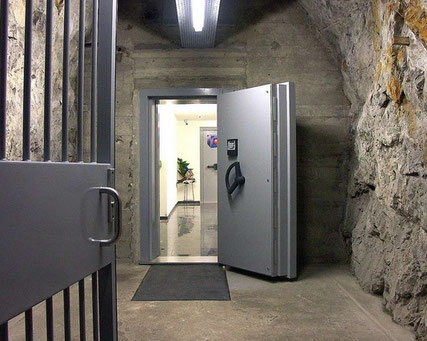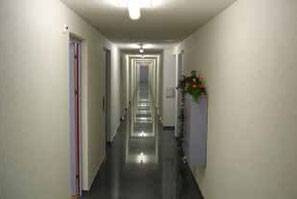Bring Your Assets Into The "Swiss Reduit

The St. Gotthard duty-free storage facility is located in a former bunker within a granite mountain massif. It has bullet and explosion proof doors. This high-security vaulting facility is one of the safest storage locations in the world and is located only 90 km south of Zurich in central Switzerland - making it easily accessible by car or train. Originally, the tunnels in the St. Gotthard massif were part of the so-called "Swiss Reduit", a military defense system.

The Swiss government and military built these bunkers for protection during the Second World War. The defense system consisted of about 20,000 bunkers and moved along the northern and eastern border of Switzerland to the border with Liechtenstein. After the fall of the Iron Curtain, a large part of the facilities were demilitarized and sold to private investors, including today's duty-free warehouse St. Gotthard. What better place to store in Europe could there be for your precious metals than this 24/7 guarded vault in the St. Gotthard mountain massif?
In 2009, the Swiss television SF showed the documentary "Geheimsache Gotthardfestung: Auf den Spuren des "Réduit national" (Secret Matter Gotthard Fortress: In the footsteps of Réduit national"), in which they report on the history of the bunkers and today's vault facilities in the Swiss Alps. The documentary can be viewed below in full length (in German only):
Excerpts from the documentary:
From the inside of the Alps, Switzerland wanted to defend itself against Hitler - with its so-called Réduit strategy. It is a journey into the time of the Second World War, to the time of the Réduit, when Switzerland began to hollow out some parts of the Alps and transform it into armed fortresses and bunkers. For decades, these military facilities were strictly secret, and those who betrayed them went to jail. Just until recently, pictures were not allowed to be published. It was the time when the government, in the heart of Switzerland, had drawn a new hypothetical border at the lake "Vierwaldstätter See". To this very point, the Réduit would have extended.
The fear of the war was a reality. The Swiss Government announced its strategy to the public via the radio, when Prime Minister Marcel Pilet-Golaz held his controversial speech: "The Swiss people must now adapt to the new situation. They must stop talking, but act. The happenings are escalating, Switzerland must adapt to this rhythm. That's the only way to give the country a perspective." The Prime Minister's speech did not go down well with the people. In the midst of this resigned and discouraged politics comes one person who gives back to the people the belief in their own strength – Henri Guisan. And he now finds the right words: "I do not only believe in the necessity and the duty, but also in the effective way to defend ourselves." In this case, defending means not only holding, but hitting and destroying with all our strength to sell life as dearly as possible." A haunting appeal, and the general feels a great deal to the people. The plan he presents to the Swiss people is not brand new but foolhardy.
The general propagates the retreat of the troops into the Réduit, which is deep into the mountains. The innermost part of Switzerland: They wanted to defend a kidney-shaped piece – and in the very center was the St. Gotthard. A plan that the general of the army and the people had to make clearly plausible: To bunker Switzerland into the Alps. The Alps, to a certain extent the heart of Switzerland, are caved out in a gigantic action. In the mountains were created countless heavily armed bunkers and fortifications that are adapted to the terrain and were barely visible. A handful of soldiers trapped inside the mountains, that would have been the Réduit. The industry in central Switzerland and the populous cities with all the wives and children would have been extradited to the enemy in case of an emergency. From today's perspective, hardly comprehensible. At that time, the decision was widely accepted. "He said we're retreating to the Réduit, but that does not mean that we adapt, but that we demonstrate resistance."
"The Gotthard was simply a symbol and it is also the reason why the Germans did not attack us and packed us, because they knew exactly that the Swiss would destroy the St. Gotthard tunnel so that the north-south connection between Germany and Italy would have been destroyed. They would not have won anything but they would have had to use many troops without any kind of compensation. This was the strategy of a high ticket price which we also used later (in the Cold War)."
The current Swiss Defense Minister, Ueli Maurer, noted: "I am convinced that the Réduit is not just an idea but a reinforcement along the terrain, where it is strong. Military speaking, we would even today try to be there, where we have a good chance, to hide or to build a defense line. The Réduit is something natural in our country, a natural isolation by means of the mountains, the narrowness. When you want to stop someone, you do not go to the big grassland which everyone can drive around, but to where he must go through. That's what Wilhelm Tell at the Gessler already knew and the Réduit is similar. You have to understand that from the time back then. The Réduit thought gave back the confidence in our own defence ability or defense possibility. That is why the Réduit also included a psychological aspect. And that is why the Réduit still exists in many heads because it propagated the belief that we could make it." Reporter: "Would you have done it?" Maurer: "Yes, I'm fully convinced of that."
Until the 1990s, until the end of the Cold War, Switzerland had maintained its bunker strategy, cultivated its hedgehog mentality and put high hopes on its secret fortresses within the mountains. On the way to Canton Uri to Amsteg – here, hidden deep in the rock and, just until a few years ago, absolutely secret: The Brindlistollen, the former government bunker from the 2nd World War, the first there was in Switzerland. Not far from Amsteg is the former Bundesratsbunker. The dimensions of the bunker are huge. In case of emergency, in addition to the seven members of the government, 372 people, as well as 123 passenger cars and 13 trucks, had space inside. The special feature of this government bunker reveals itself in the middle of the cavern, a second completely different construction. Homely like in a real chalet it is here. The feeling of the bunker is completely lost.


